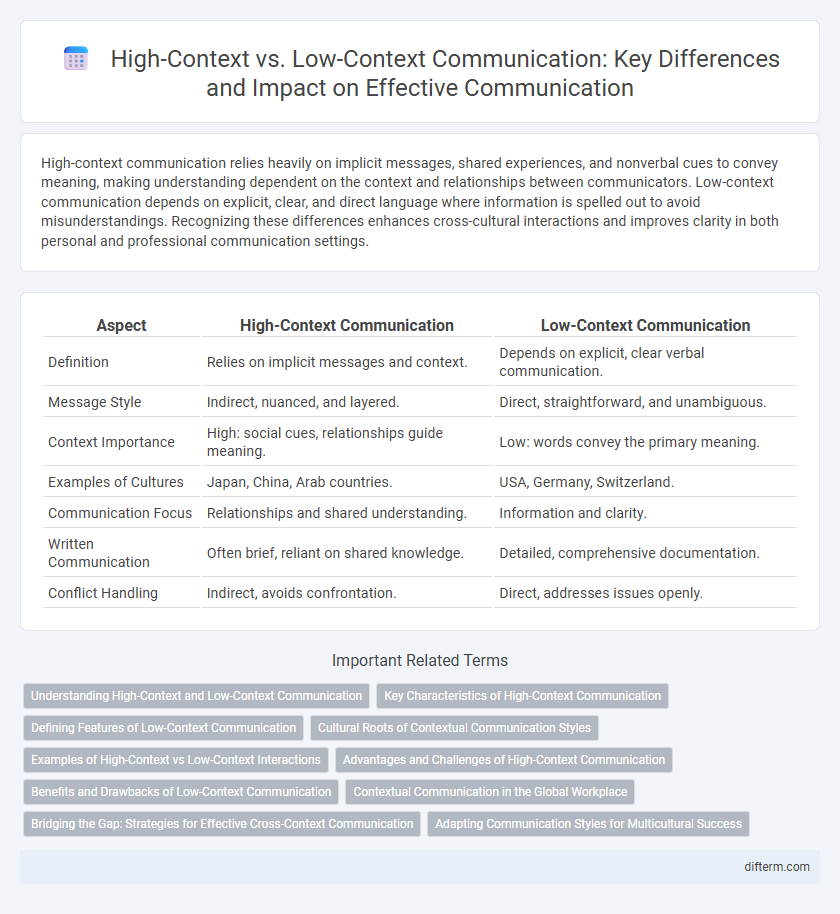High-context communication relies heavily on implicit messages, shared experiences, and nonverbal cues to convey meaning, making understanding dependent on the context and relationships between communicators. Low-context communication depends on explicit, clear, and direct language where information is spelled out to avoid misunderstandings. Recognizing these differences enhances cross-cultural interactions and improves clarity in both personal and professional communication settings.
Table of Comparison
| Aspect | High-Context Communication | Low-Context Communication |
|---|---|---|
| Definition | Relies on implicit messages and context. | Depends on explicit, clear verbal communication. |
| Message Style | Indirect, nuanced, and layered. | Direct, straightforward, and unambiguous. |
| Context Importance | High: social cues, relationships guide meaning. | Low: words convey the primary meaning. |
| Examples of Cultures | Japan, China, Arab countries. | USA, Germany, Switzerland. |
| Communication Focus | Relationships and shared understanding. | Information and clarity. |
| Written Communication | Often brief, reliant on shared knowledge. | Detailed, comprehensive documentation. |
| Conflict Handling | Indirect, avoids confrontation. | Direct, addresses issues openly. |
Understanding High-Context and Low-Context Communication
High-context communication relies heavily on implicit messages, nonverbal cues, and shared cultural understanding, making context and relationships crucial for proper interpretation. Low-context communication emphasizes explicit, clear, and direct verbal messages, minimizing the reliance on situational factors or background knowledge. Understanding these communication styles improves cross-cultural interactions and reduces misunderstandings in global business and social environments.
Key Characteristics of High-Context Communication
High-context communication relies heavily on implicit messages, nonverbal cues, and the surrounding context to convey meaning. Relationships, social hierarchies, and shared experiences play a critical role in understanding the message without explicit verbalization. This communication style is prevalent in cultures where trust and group harmony are prioritized over direct and detailed information exchange.
Defining Features of Low-Context Communication
Low-context communication relies on explicit, clear, and direct verbal messages where meaning is conveyed primarily through words rather than nonverbal cues or shared context. It features straightforward language, detailed explanations, and a preference for written or formal communication to avoid misunderstandings. Cultures such as the United States and Germany exemplify low-context communication styles, emphasizing individualism and clarity.
Cultural Roots of Contextual Communication Styles
High-context communication is deeply rooted in cultures with strong communal ties, where shared experiences and nonverbal cues convey meaning beyond words. Low-context communication predominates in individualistic societies, emphasizing explicit, direct language to ensure clarity across diverse interactions. Understanding these cultural roots reveals how social norms and historical relationships shape communication styles, influencing global business and interpersonal exchanges.
Examples of High-Context vs Low-Context Interactions
In high-context communication, much of the information is conveyed through implicit messages, body language, and shared cultural understanding, as seen in Japanese business meetings where trust and relationships outweigh explicit verbal agreements. Low-context communication relies heavily on direct, clear, and explicit messages, exemplified by American corporate environments where contracts and straightforward instructions are prioritized to avoid ambiguity. These contrasting interaction styles highlight the importance of cultural awareness in cross-cultural communication to ensure effective interpretation and response.
Advantages and Challenges of High-Context Communication
High-context communication relies heavily on implicit messages, shared experiences, and nonverbal cues, which fosters strong interpersonal relationships and efficient understanding within close-knit groups. This communication style enhances trust and harmony but can create challenges for outsiders who may find the lack of explicit information confusing or ambiguous. Navigating high-context interactions requires cultural sensitivity and attentiveness to context, as misinterpretations can occur without clear verbal expressions.
Benefits and Drawbacks of Low-Context Communication
Low-context communication offers clear, explicit messages that minimize misunderstandings, making it ideal for diverse or multicultural environments where clarity is essential. This communication style enhances efficiency and accountability by relying on direct verbal expression rather than shared background knowledge. However, its drawback lies in potentially overlooking subtle social cues and relationship dynamics, which can lead to perceived impersonality or misunderstandings in cultures that value context and nonverbal signals.
Contextual Communication in the Global Workplace
High-context communication relies heavily on implicit messages, cultural cues, and shared understanding, making it prevalent in collectivist societies such as Japan and Arab countries. Low-context communication emphasizes explicit, direct, and clear verbal information, common in individualistic cultures like the United States and Germany. Effective global workplace communication necessitates recognizing these differences to navigate misunderstandings and foster collaboration across diverse cultural environments.
Bridging the Gap: Strategies for Effective Cross-Context Communication
High-context communication relies heavily on implicit messages and nonverbal cues, while low-context communication depends on explicit, direct language, creating challenges in cross-context interactions. Strategies for bridging this gap include active listening, cultural empathy, and clarifying assumptions to ensure mutual understanding. Utilizing these approaches enhances collaboration and reduces misunderstandings in global and multicultural communication settings.
Adapting Communication Styles for Multicultural Success
High-context communication relies heavily on implicit messages, nonverbal cues, and shared cultural understanding, often prevalent in Asian and Middle Eastern cultures. Low-context communication emphasizes explicit, clear, and direct language typical of Western cultures like the United States and Germany. Adapting communication styles for multicultural success requires recognizing these differences, adjusting message clarity, and fostering cultural sensitivity to enhance collaboration and minimize misunderstandings.
high-context communication vs low-context communication Infographic

 difterm.com
difterm.com